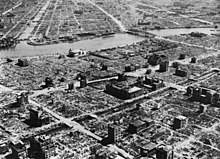Area bombardment
In military aviation, area bombardment or area bombing is a type of aerial bombardment in which bombs are dropped over the general area of a target.
[1] The term "area bombing" came into prominence during World War II.
[2] It can serve several intertwined purposes: to disrupt the production of military materiel, to disrupt lines of communications, to divert the enemy's industrial and military resources from the primary battlefield to air defence and infrastructure repair, and to demoralise the enemy's population (See terror bombing).
The latter is directed at a selected target – not necessarily a small, and not necessarily a tactical target, as it could be an airfield or a factory – and it does not intend to inflict a widespread damage.
This military-related article is a stub.

